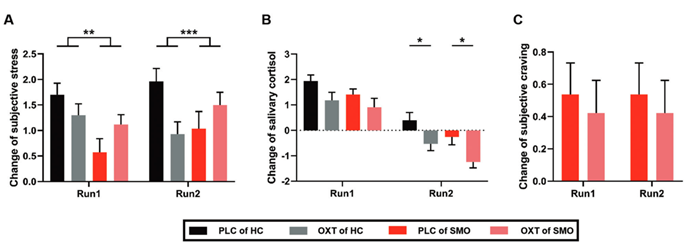A research team led by Associate Researcher WEI Zhengde and Prof. ZHANG Xiaochu from the University of Science and Technology of China (USTC) revealed the neural mechanism of interaction between oxytocin (OXT) and nicotine addiction in stress relief with transcranial direct current stimulation (tDCS) experiment and functional magnetic resonance imaging(fMRI) techniques. The study was published in Translational Psychiatry.
OXT, a neuropeptide well-known for its anxiolytic properties, can alleviate both subjective stress levels and neuroendocrine stress responses in healthy individuals. However, smokers experience a diminished response to OXT’s stress-relief effects. Therefore, there is an urgent need to explore the connection between OXT and nicotine-addicted individuals.
In this study, the researchers conducted an experiment using fMRI and tDCS to evaluate OXT’s impact on stress in both healthy controls and smokers. It was shown that while OXT significantly reduced stress scores and salivary cortisol levels (the stress hormone) in the control group, the same effects were not observed in smokers.

Effects of oxytocin and nicotine addiction on subjective ratings and salivary cortisol levels. (Image by WEI et al.)
To investigate potential ways to restore OXT’s stress-reducing efficacy in smokers, the team applied tDCS to the anterior superior temporal gyrus (anterior rSTG) which plays a key role in processing social and emotional information. After stimulation, smokers showed a significant reduction in stress scores and salivary cortisol levels, indicating that tDCS may help recover their sensitivity to OXT’s effects.
Researchers further utilized psychophysiological interaction (PPI) analysis, revealing that OXT treatment weakened the functional connectivity between the anterior rSTG and the right middle frontal gyrus (rMFG). Notably, tDCS stimulation improved this connectivity, thereby enhancing OXT's anxiolytic impact.
This research highlights the weakened stress-relieving effect of OXT in smokers, paving the way for developing new anti-stress interventions for smokers.
Paper link: https://doi.org/10.1038/s41398-024-03016-5
(Written by SHEN Xinyi, edited by HUANG Rui, USTC News Center)